


This week for Flora and Fauna Friday we have the sandhill silo-makers with their sand grain granaries, the Florida Harvester Ant (Pogonomyrmex badius).
The Florida Harvester Ant is a native species of ant with a narrow range within the United States. They’re chiefly found in Florida but also have two narrow strips of habitat running through South Carolina, one through the sandhills of the midlands and another along the Sea Islands of the coast. This is because they build their nests in deep sand, which can only readily be found in these two geologic regions of South Carolina. They are commonly found in habitats that can thoroughly be described as dry sand, specifically they prefer open grasslands and dry savannas. Their nests are easy to spot, shallow mounds of pure, vegetation-free sand with a pencil sized hole or two near the center, and usually abuzz with big red ants.
Our ants themselves are hard to miss too. They’re a hearty brick-red with a coat of fine hairs all over and fairly large. There are three classes of ant you’ll see scurrying across the surface, each of a different size and shape. The smallest and most numerous are the minor workers with relatively slender proportions and measuring in at only about a quarter-inch in length. Next are the median workers who look much the same as the minor workers but a little larger with a slightly bigger head. Lastly, the most striking is the major worker who comes in at three-eighths of an inch with a disproportionately large head. Each of these worker classes has a different role and they’re shaped according to those roles. This comes with the caveat that all these roles overlap to some degree yet some ants are better suited to certain tasks than others. Minor workers do the bulk of the work, moving soil, tending to larvae, and collecting food. Medians help as well and do some of the heavier lifting like scouting, moving larger food, and attacking prey. Major workers are, predictably, the heavy hitters. They’re there for tearing apart food, so it can fit into the nest, and defending the nest from attackers.
Speaking of defense, like most ants their primary form of defense is their stinger and the venom it injects. I can tell you from first hand, and foot, experience that that venom is no joke. The sting of the Florida Harvester Ant is up there with a paper wasp, if not worse. It will burn and throb for almost 24-hours if you have the misfortune to aggravate these ants. Thankfully, our Harvester Ants are mainly pacifists. Unlike Fire Ants, Yellow Jackets, and certain species of Paper Wasp, they won’t sting you unless absolutely necessary. They don’t climb clothing and they don’t swarm. You pretty much have to stand on a nest barefoot. This pacifism, I believe, is largely due to their primarily vegetarian diet. Harvester Ants, as you may surmise from the name, harvest, specifically they harvest seeds. They do eat insects and small vertebrates when afforded the opportunity but generally subsist off of grass and broadleaf weed seeds, which they store underground in larders for future use. Fun fact, they’re fond of white millet and will pick up scattered birdseed to bring back to their nest.

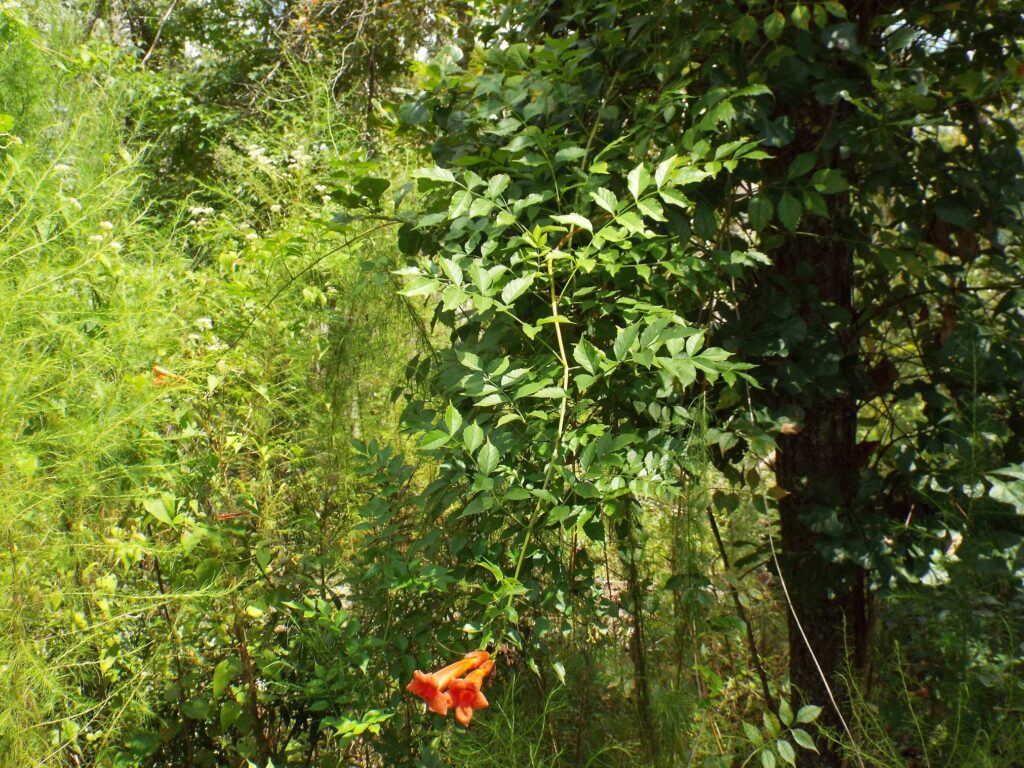
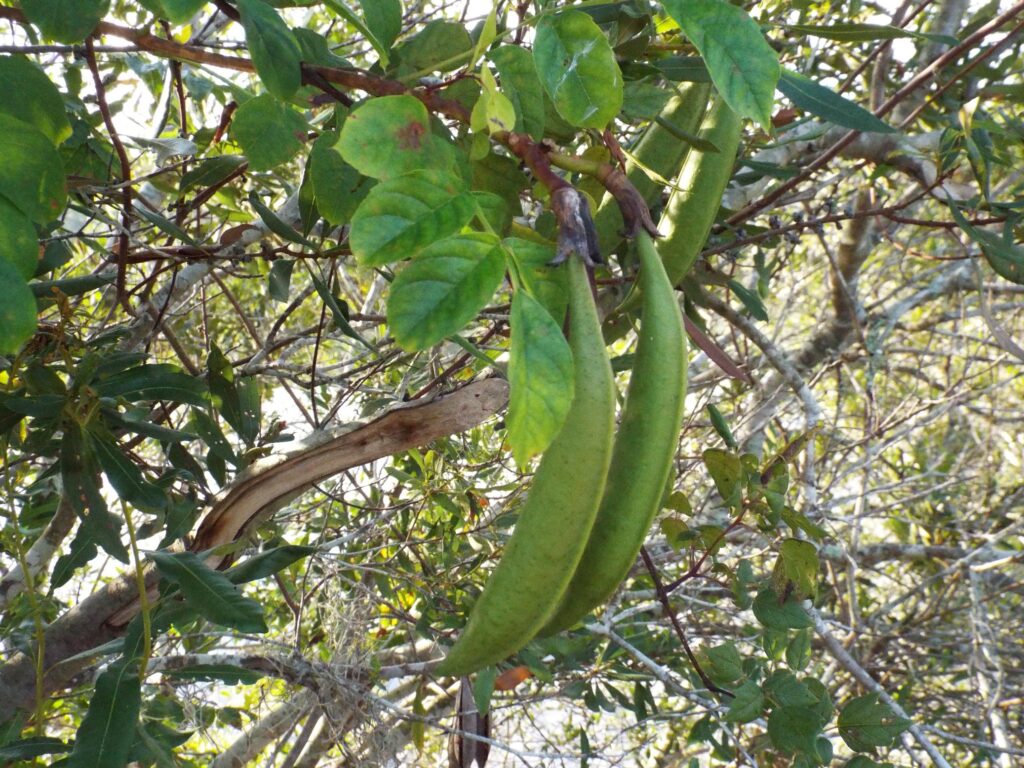
This week for Flora and Fauna Friday it’s the hummingbird’s horn-of-plenty, Trumpet-vine (Campsis radicans).
Trumpet-vine is found throughout the Eastern United States and the plant goes by many names. I prefer Trumpet-vine if for nothing else than the direct simplicity of it: Trumpet vine is a vine with trumpet flowers. Trumpet-vine is one of our several species of aggressive climbing vines. While nowhere near as destructive to trees as our Grapes and Greenbriers, it can give Poison-Ivy and Virginia Creeper a run for their money in the medium-weight division. Like Poison-Ivy, Trumpet-vine climbs with rootlets. These rootlets grow into cracks, crevices, and pores before swelling up and locking the vine in place. This allows Trumpet-vine to grow straight up pine trees and brick walls. As Trumpet-vine ages, its main vine grows with it and can reach several inches in diameter in a few decades. Trumpet-vine bark is pale gray with long vertical ridges and strings. The leaves of Trumpet-vine are opposite, pinnately compound (like an Ash) and a light emerald-green with deeply toothed margins and furrowed veins. When at the top of a small tree or the crook of a limb, their vines often weave themselves into a large mass of stems sheathed in a dense ball of foliage. The real draw of Trumpet-vine, however, is in its flowers.
Trumpet-vine can bloom throughout the growing season but tends to peak in the Lowcountry from May through July. Flowers appear at the end of the stems and are produced in clusters of about 5 to 10 flowers. Each flower is conical in shape with a flared 5-petalled mouth on a finger-sized tube painted in the full gradient of warm colors with a lemon yellow base, orange throat, red mouth, and watermelon lips. Despite the size and flamboyance of their flowers, they can often go unnoticed. Trumpet-vine blooms where it’s actively growing, which is usually at its highest point. So sometimes the lowest flowers on a vine may be 25 feet or higher in the trees where you may not even notice they’re there unless your path crosses with a fallen flower. However, this height and their shape make them an ideal food source for Hummingbirds. Other than bees and a few large butterflies, nothing else can make use of these blooms by day but sphinx, hawk, and hummingbird moths will visit them after dark. By the shape of the blooms, you can tell Trumpet-vine planned on having Hummers over for dinner. Their anthers are positioned just so at the top of the flower to deposit a dollop of pollen on the forehead of any visiting hummer and their funnel shape makes sure they have to bump it. Trumpet-vine and Crossvine have very similar life histories in this regard but Crossvine has a much narrower flowering period that ends right about when Trumpet-vine starts. Throughout spring and early summer, I’d reckon Trumpet-vine is the primary food source of most of our hummingbirds. Seeds are produced from long pods and spread by wind. Trumpet-vine will also spread by its roots if damaged. Trumpet-vine takes well to home gardens too and will gladly smother whatever you plant it beside while it supplies nectar to your local pollinators. It’s best given its own trellis or just allowed to swallow a gazebo or pergola.
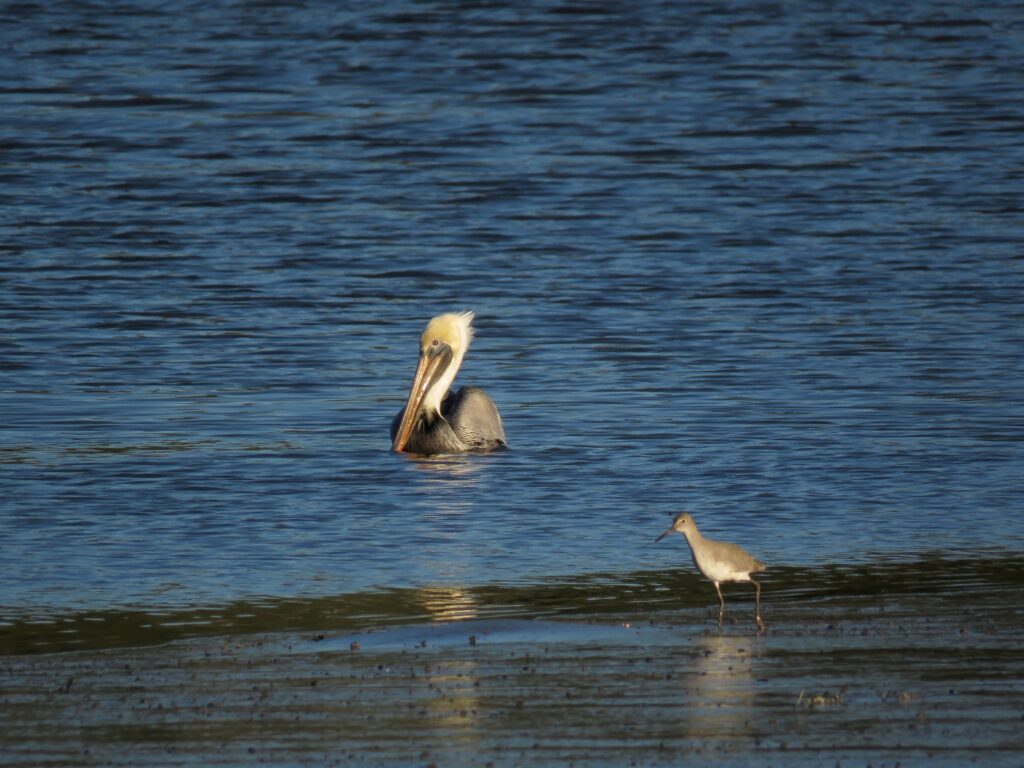
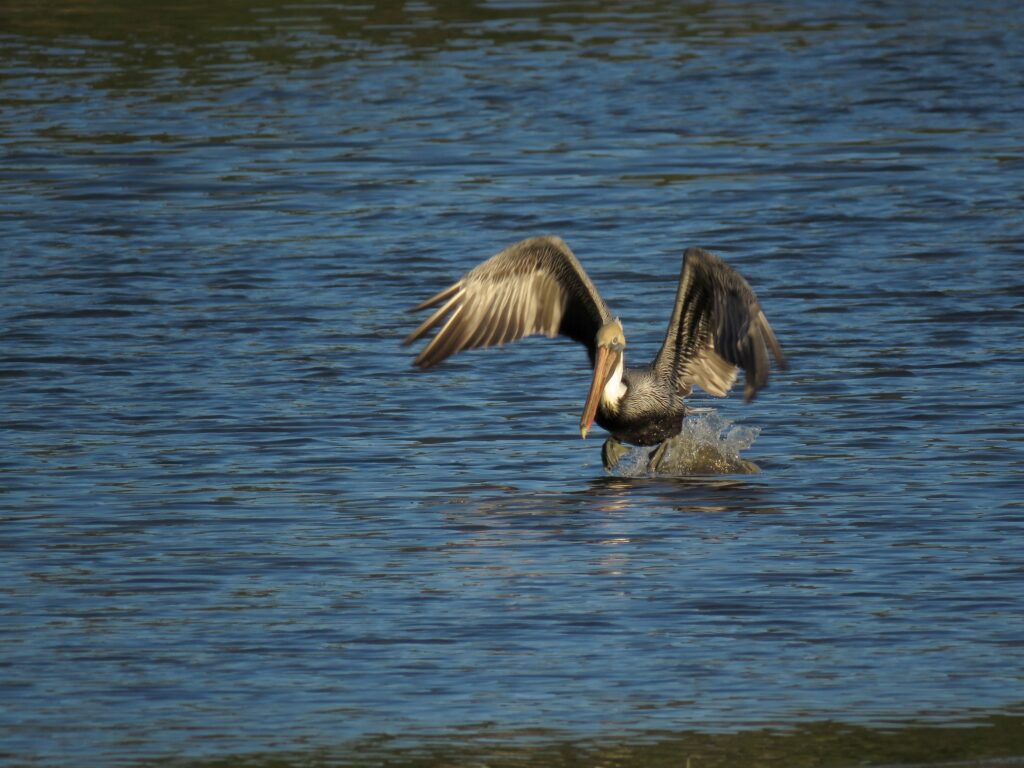
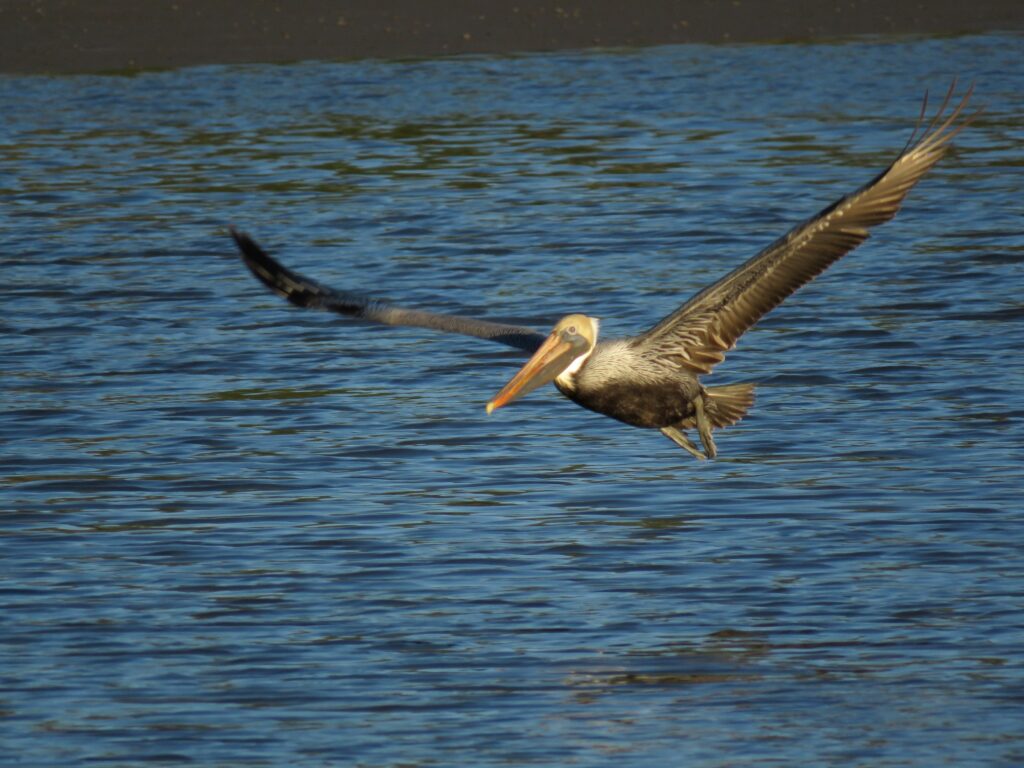
This week for Flora and Fauna Friday we have a staple seashore sailor, the Brown Pelican (Pelecanus occidentalis).
The breeze flows off the surf as it crashes into the strand, kicking sand into shimmering rivers. The reflective projectiles course over your ankles and ricochet off your cheeks. Squinting to brave the buffeting, shadows slap across your vision one after another. Daring to look you avert your gaze upward to greet a convoy of broad brown wings brazenly barreling into the barrage of the breeze. Before they’ve even left your sight a second set sails past only inches above the surf. A pod of Brown Pelicans tip their wings towards you as they continue along their commute.
The Brown Pelican is a very large species of bird found throughout the tidal regions of the Lowcountry. They have a heavy frame, huge wingspan, thick legs, and a long neck supporting an even longer bill. Their backs are cloaked in streaks of silver and grays and their bellies bathed in ebony-brown. Their chest tapers in to the ivory of their neck as it swoops into the blonde of their head. Below their eye hangs their massive bone-and-orange bill, tied to their neck with a stretchy shale-gray pouch. Brown Pelicans can often be found perched upright atop a pylon or pier, floating atop the ocean or creek, slicing through the air over the beach, or careening full speed in a nose dive towards the water. Brown Pelicans are plunge feeders that eat fish. Yet, they employ a unique technique from other such birds, like the Kingfisher or Osprey. Rather than spearing or grabbing the fish, Pelicans scoop. As they hit the water, they open their mouth. Their elastic throat pouch and lower jawbone expand with the force of the water to encircle the fish and, as they slow to a stop and close their mouth, the water rushes back out but the fish remains trapped in the pouch.
The Brown Pelican is a species we all know and love. It’s hard to spend more than a moment on the beach without a caravan cruising past. But it was not always this way. Brown Pelicans nearly went extinct in the 1970s. They were especially hard hit by the aftereffects of the insecticide DDT, which caused widespread nesting failure. Brown Pelicans more-or-less stand on their eggs to incubate them and DDT makes bird eggs brittle. Thus these heavy birds had quite the hard time nesting and the species was put on the endangered species list in 1970. With the ban on DDT and similar pesticides and coordinated protection efforts by USFWS and state wildlife agencies, the Brown Pelican was able to make a full recovery. By the mid-1980s, they had done a complete 180 in the southeast. In 2009 they were officially delisted across the United States. Today, with how abundant they are, it’s hard to imagine how close to the brink the species once was.
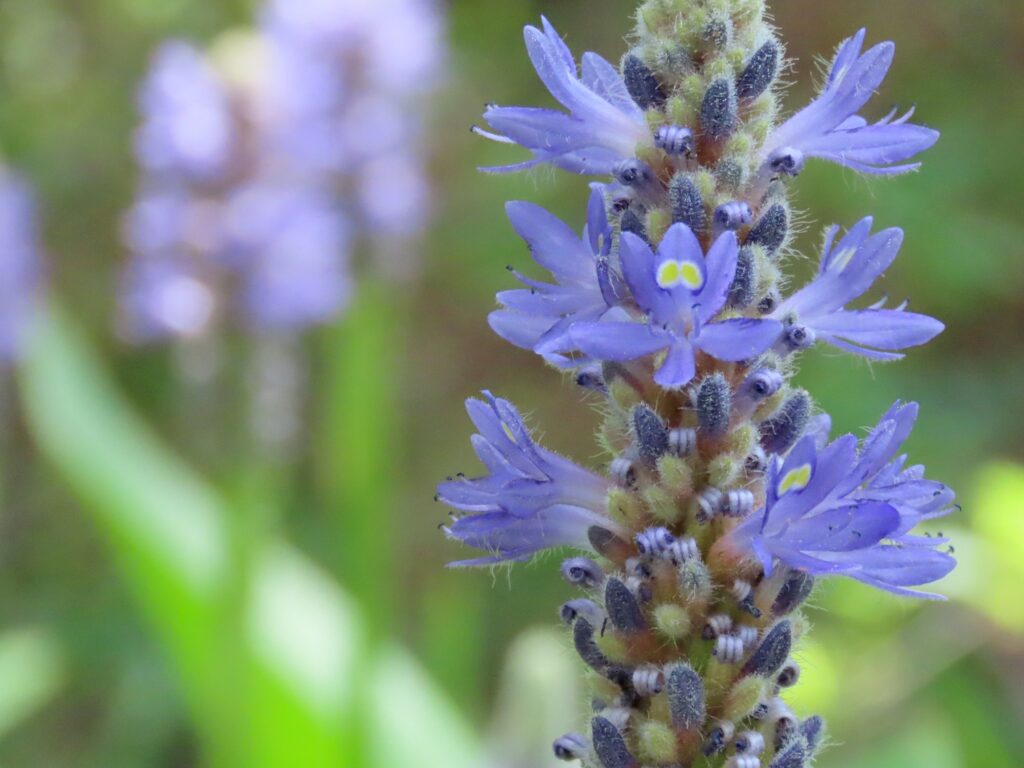
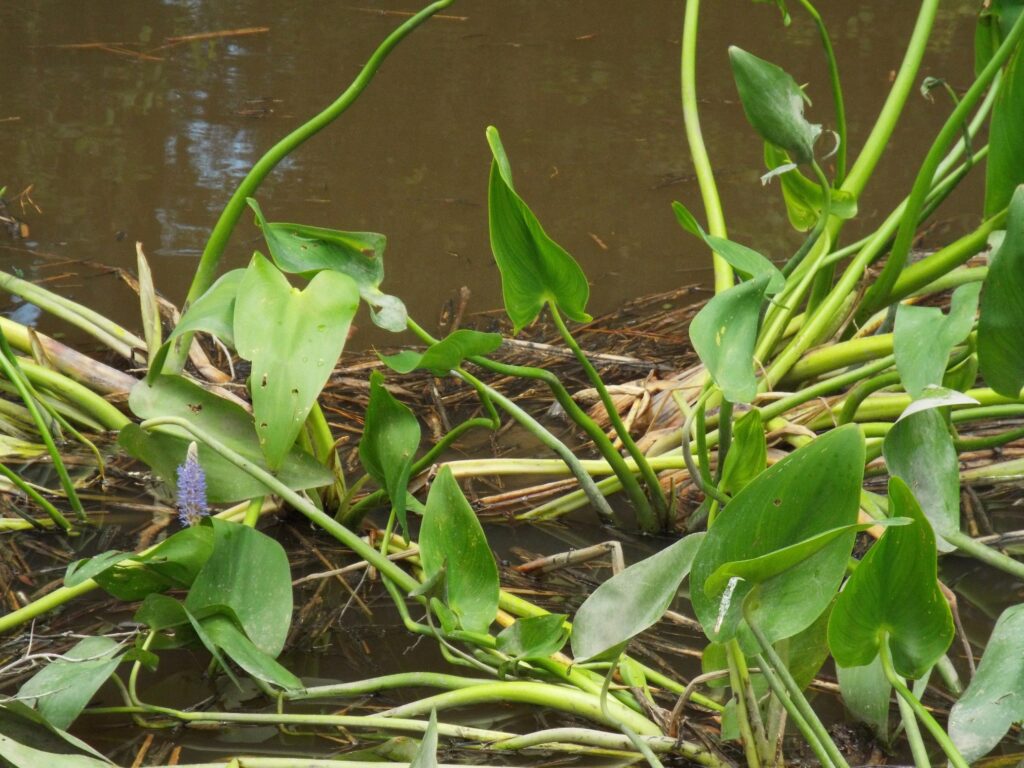
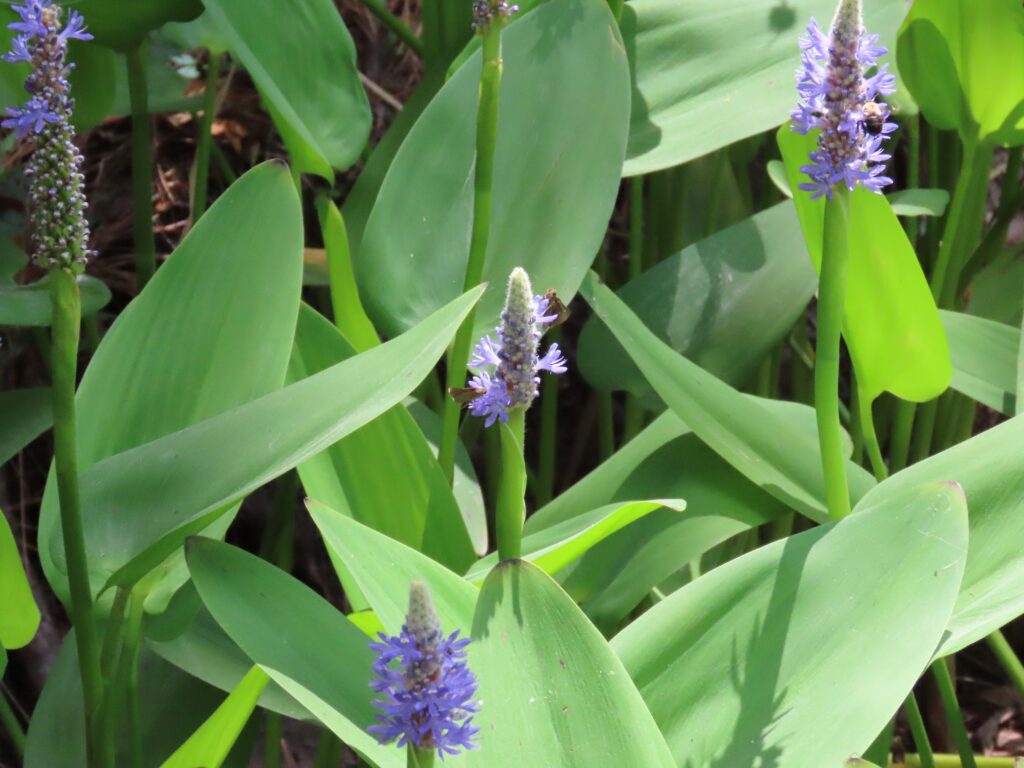
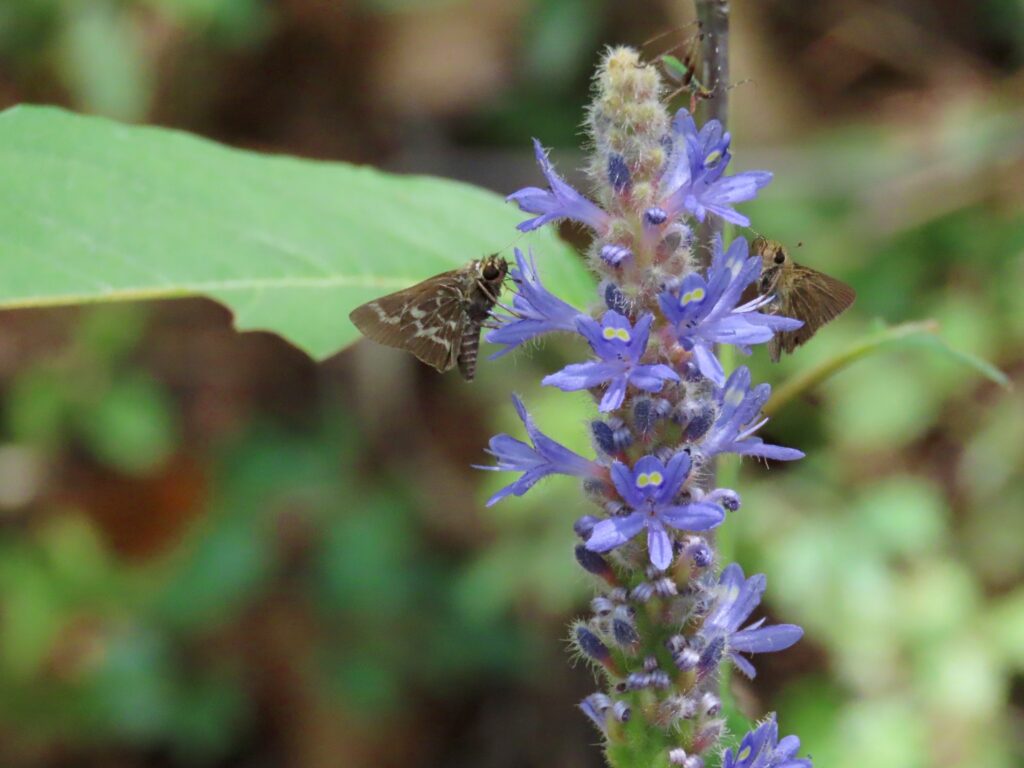
This week for Flora and Fauna Friday we have a lush lavender brush of aquatic wildflowers, Pickerelweed (Pontederia cordata).
Pickerelweed is a large perennial wetland wildflower. It’s found throughout the coastal plain, from Texas to Maine, and all along the Great Lakes. In the Lowcountry, it can be found in a wide array of freshwater wetlands, from ponds and ditches, to old rice fields and lakes, to rivers and bottomlands. Pickerelweed likes to inhabit the borders of these damp locales, where the soil is always wet but not always submerged, and so it has a particular affinity to ditches where everywhere is an edge. Pickerelweed spreads by its roots and will quickly fill up all the suitable habitat around it. The plant grows to about three-feet tall as a mass of large heart and spade-shaped leaves, each pointed upright on their own stem. Over the top of the leaves will rise the flower stalks, cupped beneath by their own individual leaf. The flower heads are hand-length spikes stacked with 6-petalled lavender flowers anointed with a drop of solar-yellow.
Pickerelweed is a long bloomer, with flowers appearing from as early as April and to as late as October. It is a tremendous nectar plant and a cornerstone in the diet of many wetland species of butterfly, bee, and fly. The plant also has some value as human forage. Young leaves can be boiled as a pot green and the seeds can be eaten raw or turned into flour. The plant gets its common name from the Pickerel, a genus of slender freshwater fish, which often occupy the same habitat on the edges of rivers and lakes.
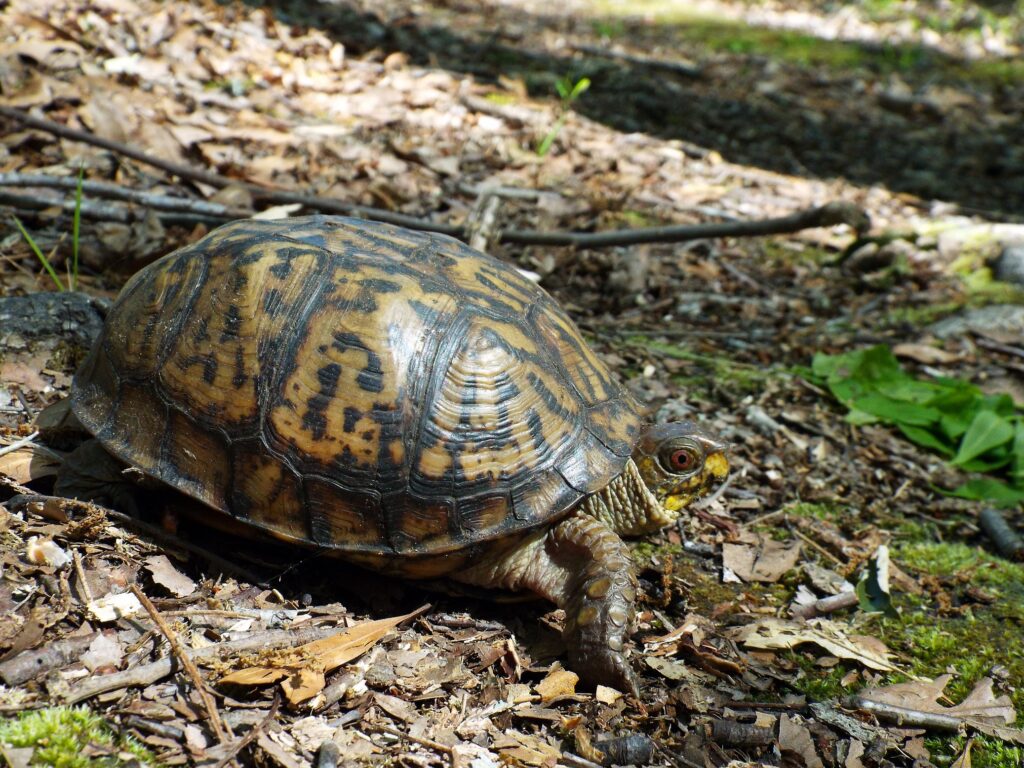
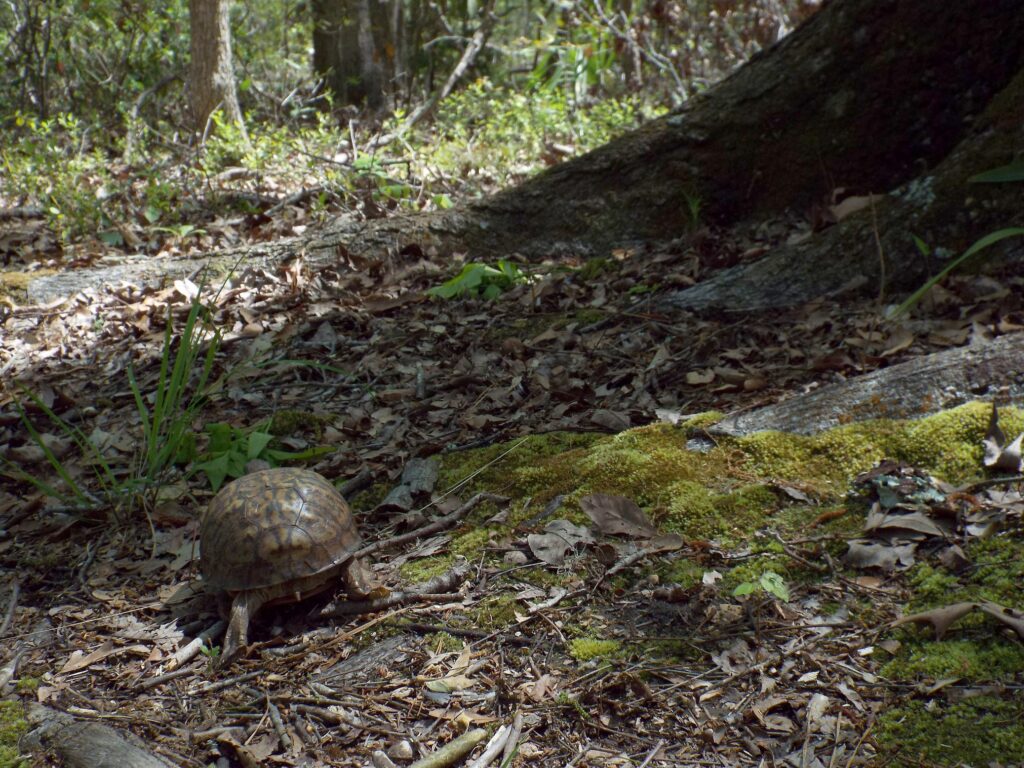
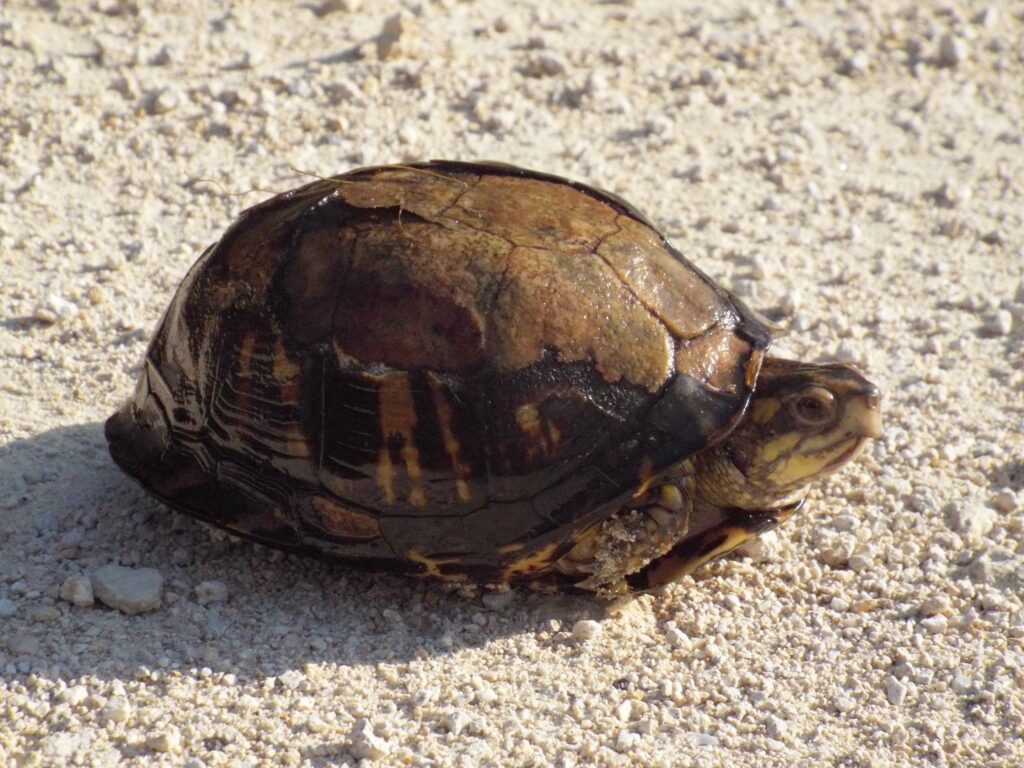
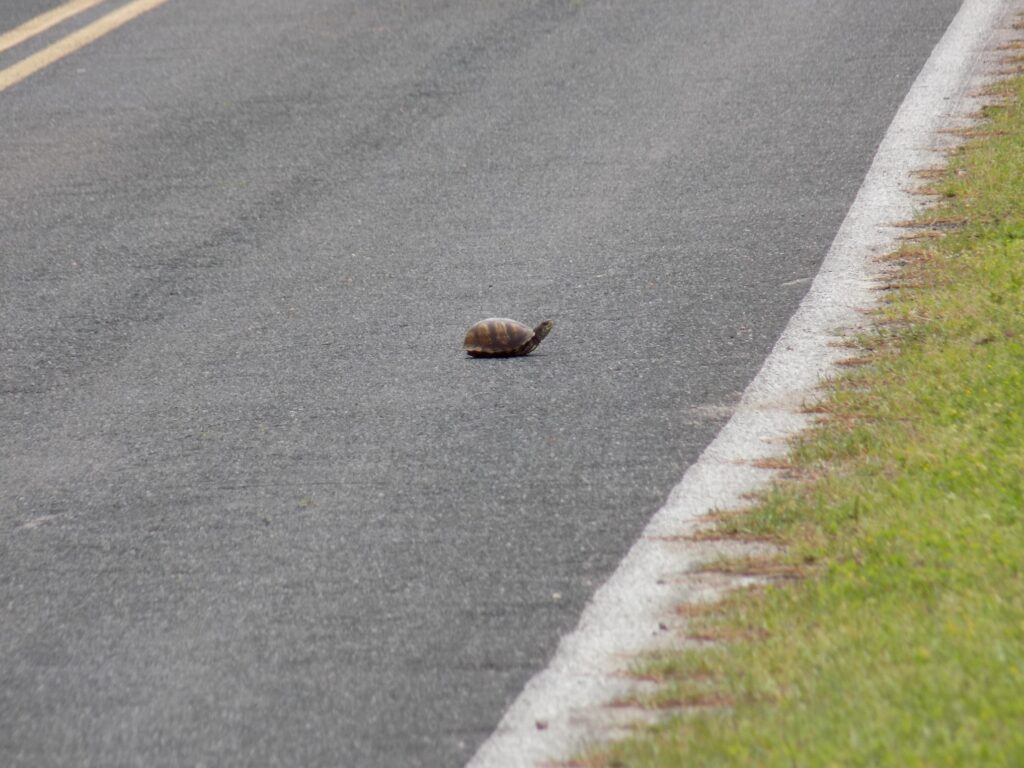
This week for Flora and Fauna Friday we have a compact reptile found around the state: the Eastern Box Turtle (Terrapene carolina carolina).
The Eastern Box Turtle is the only subspecies of the Common Box Turtle found in South Carolina. They are a terrestrial turtle, not a tortoise. (Tortoises are vegetarians and have elephant-like rear feet.) Our Turtle can be found in almost every woodland habitat in the state and even in some shallow wetlands. They are true omnivores and their diet consists primarily of invertebrates, mushrooms, and fruits but they’ll happily eat amphibians, reptiles, carrion, and some kinds of vegetation. However, they lack teeth and can’t eat seeds, nuts, or most plants. They’re a small turtle, typically only reaching 6 inches long and a pound in weight. Yet they are incredibly long lived and slow growing. The overwhelming majority of Box Turtles never make it to adulthood as more than three-quarters never make it past the first year. It takes them a decade plus to reach sexual maturity. Box Turtles eventually stop growing at a certain size, but they don’t stop living. They’ve been recorded, on multiple occasions, to handily exceed 100 years in age.
Box Turtles have a high domed shell and stubby feet. They also have a double hinged plastron (the lower half of the shell) which allows them to fully retract their bodies within their shells and leave nothing exposed to danger. This is where they get the name of “Box” Turtle, as they close up tight like a box. Box Turtles are nearly invulnerable in this state to everything but Black Bears. Males are beautifully patterned across their bodies in yellow, orange, and red. Each scale and scute adorned with prehistoric prints of fiery paints. Females are duller but no less aesthetic. Aggressive reds are avoided in favor of crisp yellows, wisps of orange, and intricate matte interplays of sand, bone, and slate. No two turtles are marked the same. Here in the Lowcountry both males and females have red eyes, despite what you may read in field guides. Though, males have a white base color to their iris which makes their eyes appear scarlet red to rosy pink. Females are a deeper red, from ruby to brick.
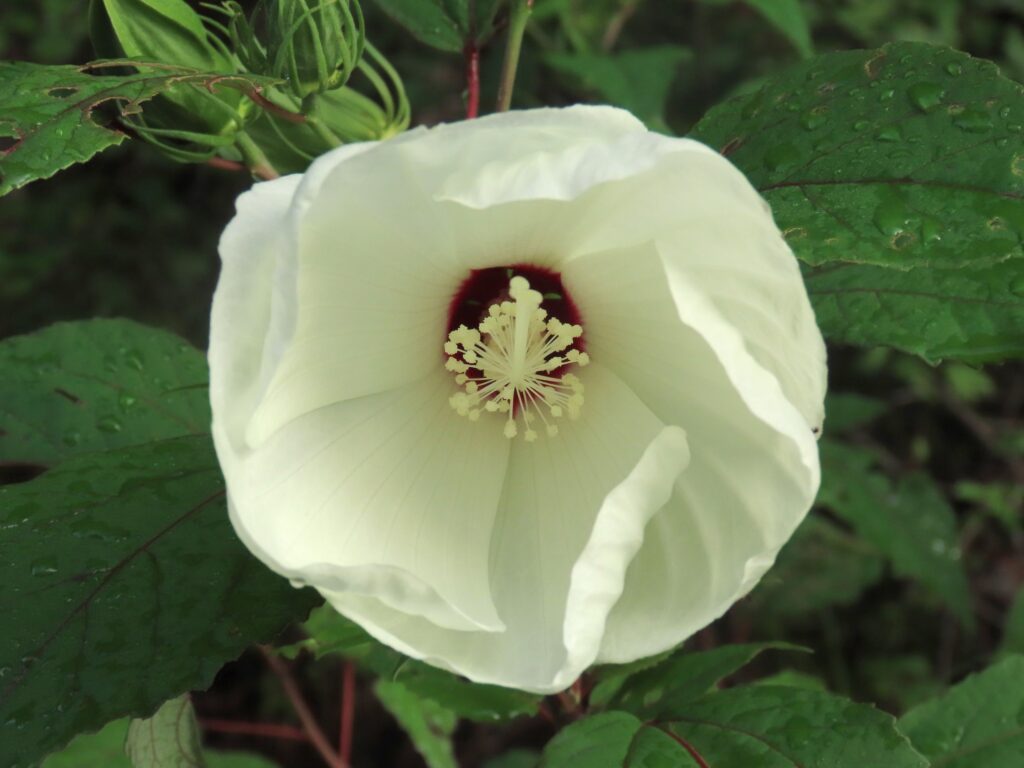
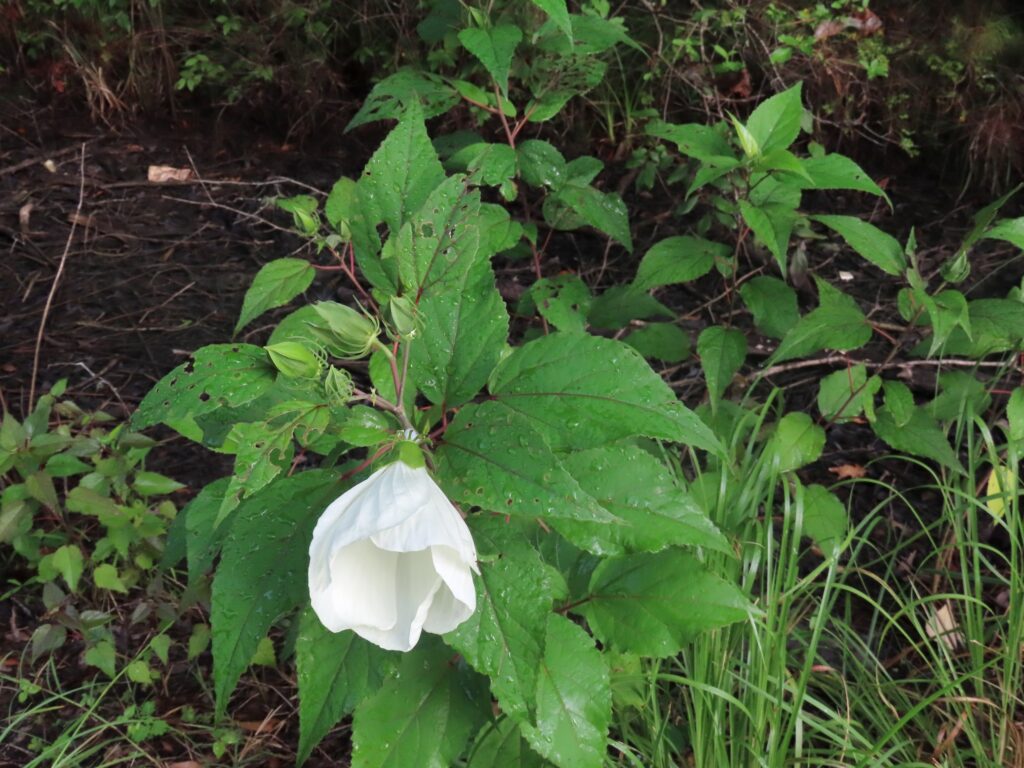

This week for Flora and Fauna Friday, it’s a large riparian wildflower found in our ditches and riversides: Crimson-eyed Rosemallow (Hibiscus moscheutos).
Crimson-eyed Rosemallow is a large wetland perennial that grows in clumps a few feet around and over head-high. They’re most commonly found in freshwater marshes and roadside ditches bordering existing floodplains. Plants often clump together but don’t readily spread by their roots. Stems die back to the roots but return in late spring. Leaves are hand-sized and diamond-shaped with ragged edges. However, the real show stopper is the flowers. Crimson-eyed Rosemallow is best known for its giant, stunning flowers that can be as large as your spread hand. As a member of the Mallows, Crimson-eyed’s flowers are large and five-petalled with a bottlebrush-like projection of anthers at the center. The petals are a pure porcelain-white textured by longitudinal ribs that run down into a dark-crimson center. There are also varieties with rich pastel-pink petals but the white kind are what I primarily see in the Lowcountry. Flowering peaks between July and August and are frequented mainly by bees.
Conversations in the Field, Episode 4 is ready to go! Enjoy this informative new video of Melinda Hare, Education Outreach Coordinator, sitting down with well-known ornithologist, Dr. Sid Gauthreaux, for a fascinating discussion about migratory birds.
Dr. Gauthreaux explains why birds migrate, their natural migration cycles and patterns and recent changes in those migratory patterns as they relate to climate change and man made hazards. Sid also discusses his pioneering research using radar to track and study bird migrations around the world. This is a Conversation you don’t want to miss!
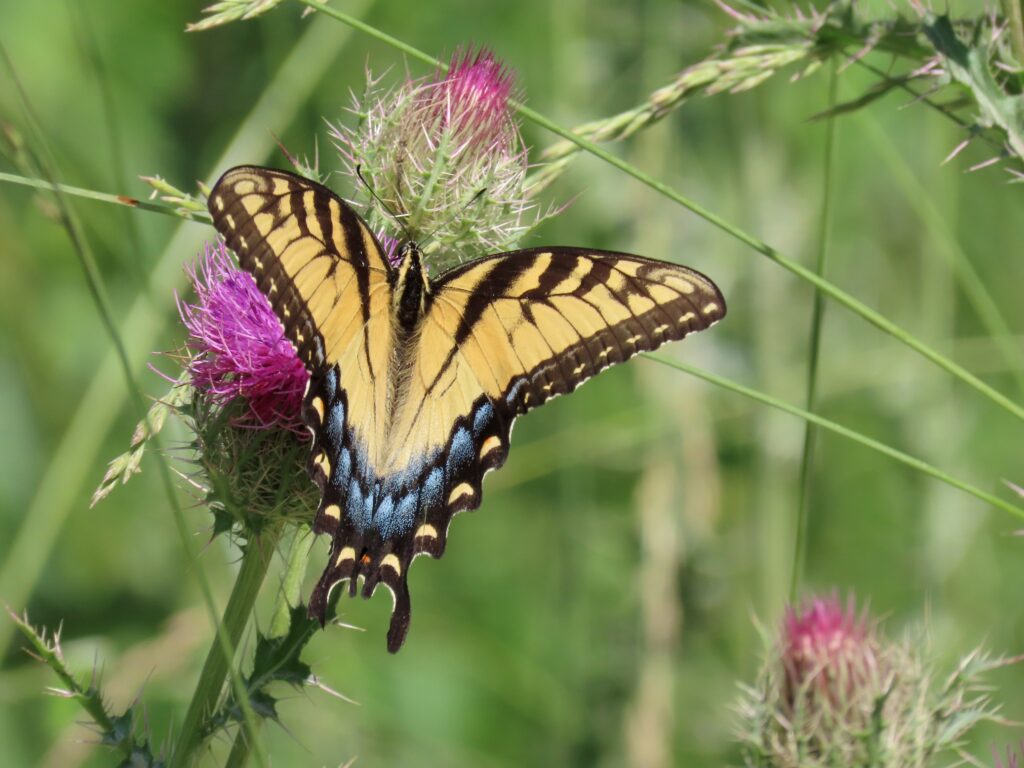
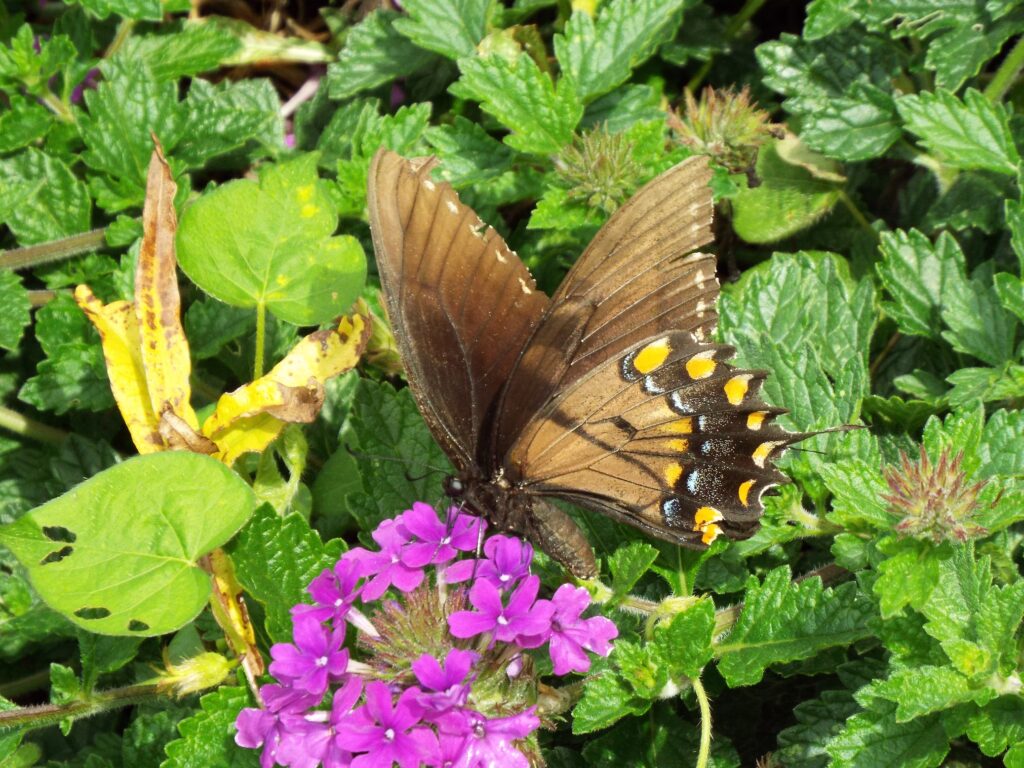

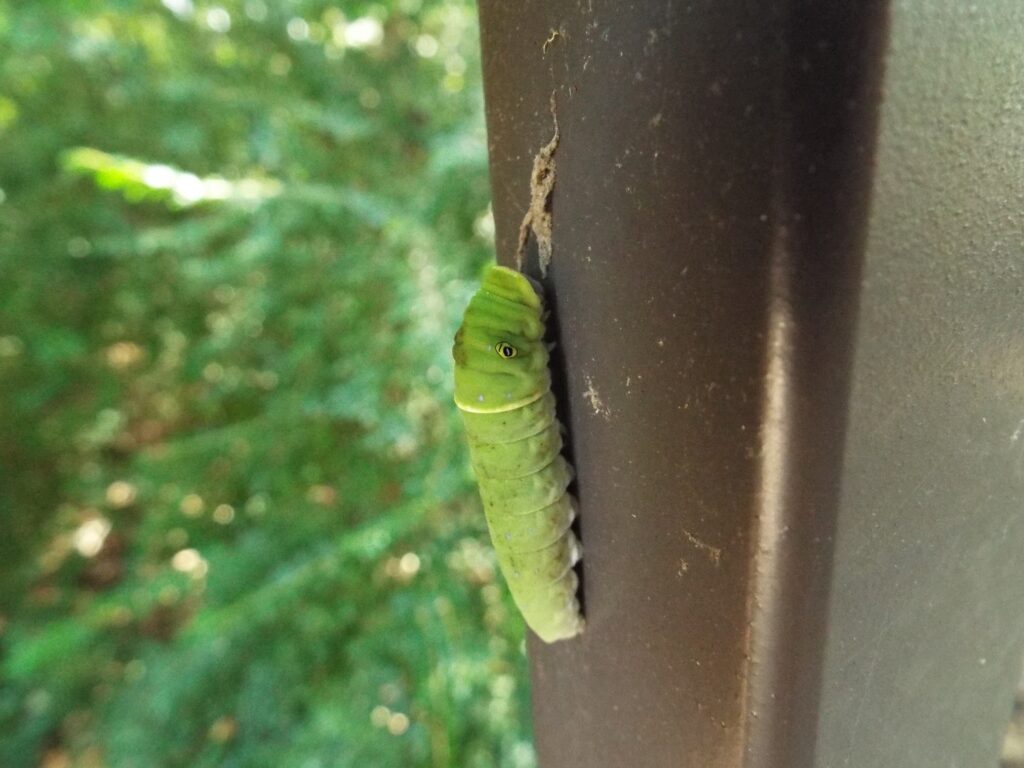
This week for Flora and Fauna Friday, we have one of our most iconic and largest butterflies: the Eastern Tiger Swallowtail (Papilio glaucus).
The Eastern Tiger Swallowtail is a large species of butterfly in the Swallowtail family found throughout the eastern United States and one of our eight species of Swallowtail in South Carolina. I believe it is tied for second place for the largest butterfly in the state with its cryptic cousin the Appalachian Swallowtail but squarely behind the first place Giant Swallowtail. Eastern Tiger Swallowtails are an unmistakable butterfly, except for when they’re not. Most Tiger Swallowtails are a rich yolk-yellow below and above that’s bordered and striped with strokes of charcoal black. Their hindwing fringes features a dash of chromatic diversity, with a splash of iridescent sky-blue and a few flecks of warm-orange. Male and females are quite similar but females tend to flaunt more substantial blue coloration. However, some female Tiger Swallowtails look radically different. Females can also appear as a dark-morph, which throws a wrench in the identification gears. Here in the Lowcountry, dark-morph female Tiger Swallowtails are not that uncommon and show up regularly in certain habitats. Dark-morphs can be quite obvious, showing faint stripes above and below through their graphite wings, or quite difficult, looking very similar to a Spicebush Swallowtail with a solid black body and almost entirely blue hindwings. The best way to identify a dark-morph female is to look for a large size, unmarked abdomen, faint stripes on the underside of the forewing, and a thin dark line running through the middle of the blue of the hindwings.
Eastern Tiger Swallowtails nectar on a wide variety of wildflowers and are a common sight almost anywhere in the Lowcountry. The reason for their abundance is in their host plants. Eastern Tiger Swallowtail caterpillars will host on a wide variety of hardwood tree species including: Black Cherry, Tulip Poplar, Sweet Bay, Ashes, and Willows. One of these tree species can be found in most any wooded habitat in the Lowcountry and so, so can Tiger Swallowtails. The caterpillar of the Eastern Tiger Swallowtail is large, cylindrical, wrinkly, and lime-green with a thin yellow collar and a comically caricatured eyespot, complete with an angry eyebrow. Caterpillars create a hidey-hole out of a leaf to rest in. They do this by weaving a carpet of silk across the surface of a leaf and, as the silk dries, it rolls the leaf up like a taco shell around them. Larger caterpillars leave their tortilla tunnel to feed but return to rest and digest.



This week for Flora and Fauna Friday is a lanky legume with a pigment pedigree, Carolina Indigo (Indigofera caroliniana).
Carolina Indigo is a small, airy shrub found on dry sandy ridges between the pines of savannas and along oak-hickory wood-lines. It often gets about chest high with wiry burgundy stems lined by small scarce leaves and covered with fine, sparse hair. The plants love bare sandy soil below dappled sunlight and so often find themselves at home in fire prone pine savannas. Much like Coralbean, Carolina Indigo dies back to its roots every winter only to reemerge the following spring. Plants bloom in June and July with slender spires of tiny peach-colored pea flowers. Seed pods are minuscule and contain only one or two seeds.
Carolina Indigo is one of three species of true Indigo that were cultivated for dye in the colonial United States. However unlike its tropical cousins, Guatemalan Indigo (I. suffruticosa) and True Indigo (I. tinctoria), Carolina Indigo was never a major cash crop. Indigo crops were grown for pigment that could be rendered from their leaves. Fresh leaves and stems were harvested, fermented in vats of water, strained, agitated, and mixed with lime from baked oyster shells to produce a deep blue dye that was then dried, cut, packaged, and sold. Indigo experienced only a brief period of profitability in South Carolina before the Revolutionary War. Guatemalan Indigo was believed to have been the species of choice on South Carolina plantations. Yet, Carolina Indigo saw some limited use as a dye early on in history as well as minor use for individual domestic dye production. Carolina Indigo never took hold for two reasons: the dye it produced was paler and it had low yield of dye per acre due to a biology that differed considerable from its imported cousins. Unlike the tropical Guatemalan Indigo which yielded dense leafy growth and grew feverishly until first frost shut it down, Carolina Indigo had adapted to the temperate climate and some of the harshest growing conditions South Carolina had to offer. This meant it grew slow, had fewer branches with less leaves, and spent more time building a robust root system to survive droughts and fires. Without any competitive commercial utility, Carolina Indigo quickly faded back to obscurity where it quietly grows along our roadsides and woodlots to this day.

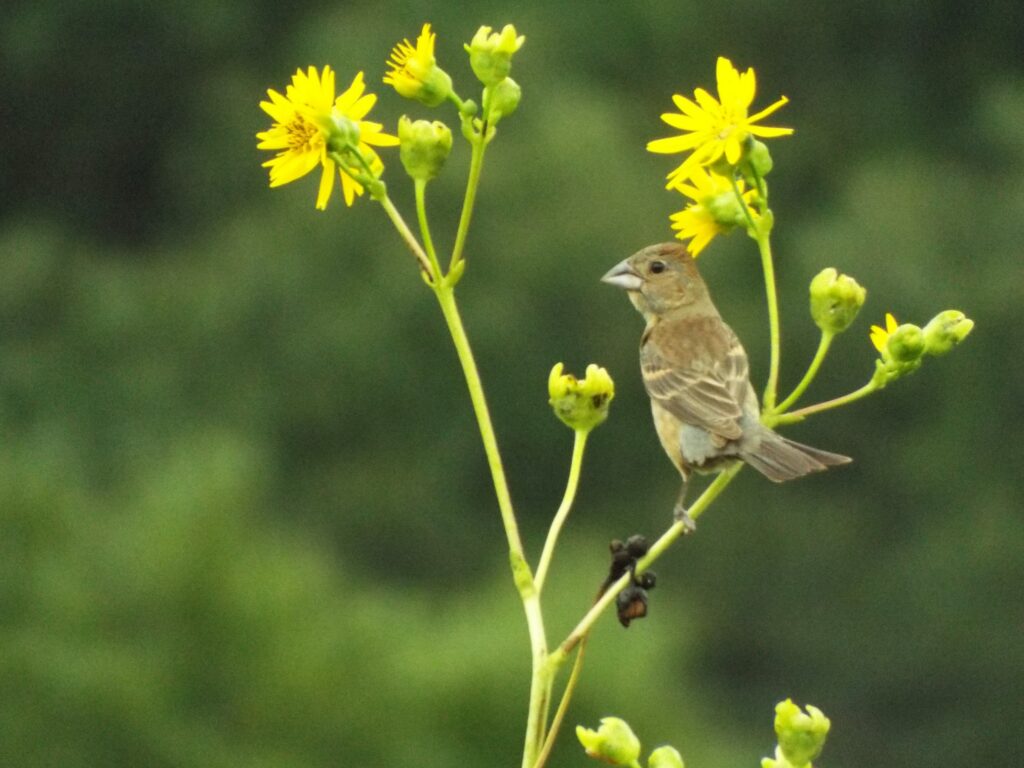
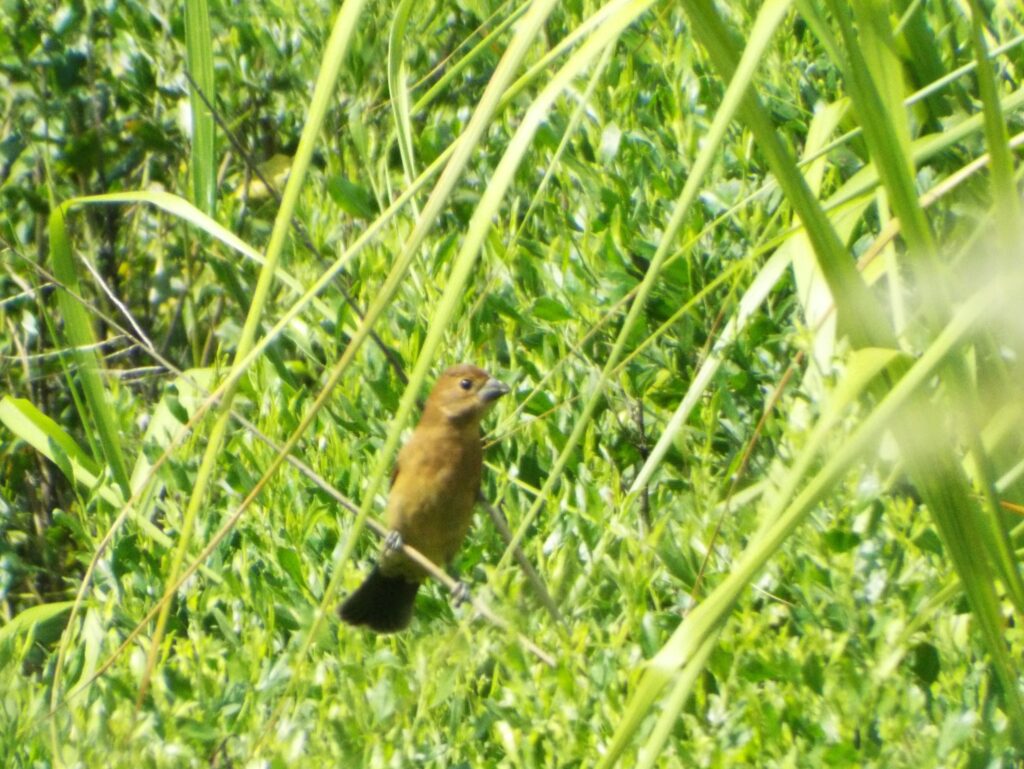
This week for Flora and Fauna Friday we have a cobalt cousin of the Cardinal, the Blue Grosbeak (Passerina caerulea).
Along the ditch within the field your train of thought derails on a curt, crisp “Tink” spit with force to split the brush and mark upon your attention. The statement receives an encore and several more as you blindly stare into the reeds and weeds for the source of the interruption. With a crane of your neck and a cock of your ear you shuffle closer. Your haphazard trespass is discovered to be unwelcomed as a dazzling whirl of cobalt rockets forth with a flutter of feathers and another, sharper, single-syllable, “Tink!” The indigo UFO skims across the shrubs to settle along a thicket and locks with your gaze before tumbling down within. Quite the common way to greet a Blue Grosbeak.
Blue Grosbeaks are a medium-sized songbird and the largest of our three Bunting species. Like its close cousins the Painted Bunting and Indigo Bunting, and it’s slightly more distant cousin the Northern Cardinal, the Blue Grosbeak is also an inarguably stunning bird to behold. Male Blue Grosbeaks are dyed a deep lazuli blue throughout that’s accented by two chestnut wing bars and fringed with jet-black flight feathers and mask. Females are not so boldly colored but still flaunt a handsome cloak of cinnamon and umber. Both sexes have a short tail, long body, and a heavy triangular bill. Grosbeaks are primarily seed-eaters but, like most songbirds, will gladly gobble up insects when given the opportunity. Grosbeaks prefer to inhabit scrublands, thickets, causeways, stream banks, and field edges and are most fond of overgrown drainage ditches in our area. Here they nest, rest, and forage. Blue Grosbeaks are more often heard than seen, spitting sharp one-note “Tink” calls at anything that comes too close to their abodes. When they are seen, it’s often briefly atop a bush or limb before darting back into the shadows of a shrub. The best time to view Blue Grosbeaks is spring when males stake their territory and sing its defenses.